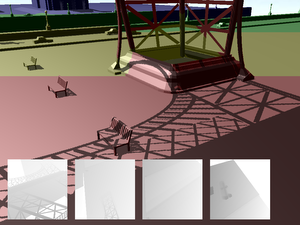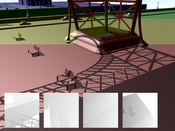Information
- Publication Type: Other Reviewed Publication
- Workgroup(s)/Project(s):
- Date: 2009
- Booktitle: ACM SIGGRAPH Asia 2009 Courses
- Location: Yokohama, Japan
- Publisher: ACM
- Note: Lecturer: Daniel Scherzer
- Conference date: 16. December 2009 – 19. December 2009
Abstract
Shadows are crucial for enhancing realism and provide important visual cues. In recent years, many important contributions have been made both for hard shadows and soft shadows. Often spurred by the tremendous increase of computational power and capabilities of graphics hardware, much progress has been made concerning visual quality and speed, making high-quality real-time shadows a reachable goal. But with the growing wealth of available choices, it is particularly difficult to pick the right solution and assess shortcomings. Because currently there is no ultimate approach available, algorithms should be selected in accordance to the context in which shadows are produced. The possibilities range across a wide spectrum; from very approximate but really efficient to slower but accurate, adapted only to smaller or only to larger sources, addressing directional lights or positional lights, or involving GPU- or CPU-heavy computations. This course tries to serve as a guide to better understand limitations and failure cases, advantages and disadvantages, and suitability of the algorithms for different application scenarios. We will focus on real-time to interactive solutions but also discuss offline approaches if needed for a better understanding.Additional Files and Images
Weblinks
BibTeX
@inproceedings{WIMMER-2009-CSR,
title = "Casting Shadows in Real Time",
author = "Elmar Eisemann and Ulf Assarsson and Michael Schwarz and
Michael Wimmer",
year = "2009",
abstract = "Shadows are crucial for enhancing realism and provide
important visual cues. In recent years, many important
contributions have been made both for hard shadows and soft
shadows. Often spurred by the tremendous increase of
computational power and capabilities of graphics hardware,
much progress has been made concerning visual quality and
speed, making high-quality real-time shadows a reachable
goal. But with the growing wealth of available choices, it
is particularly difficult to pick the right solution and
assess shortcomings. Because currently there is no ultimate
approach available, algorithms should be selected in
accordance to the context in which shadows are produced. The
possibilities range across a wide spectrum; from very
approximate but really efficient to slower but accurate,
adapted only to smaller or only to larger sources,
addressing directional lights or positional lights, or
involving GPU- or CPU-heavy computations. This course tries
to serve as a guide to better understand limitations and
failure cases, advantages and disadvantages, and suitability
of the algorithms for different application scenarios. We
will focus on real-time to interactive solutions but also
discuss offline approaches if needed for a better
understanding.",
booktitle = "ACM SIGGRAPH Asia 2009 Courses",
location = "Yokohama, Japan",
publisher = "ACM",
note = "Lecturer: Daniel Scherzer",
URL = "https://www.cg.tuwien.ac.at/research/publications/2009/WIMMER-2009-CSR/",
}


